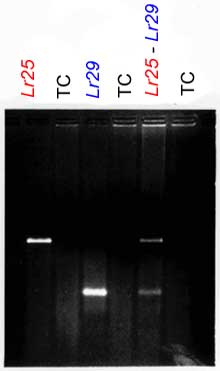Contributed by J. Douglas Procunier. Agriculture & AgriFood Canada
The leaf rust resistance gene Lr29 was transferred from Agropyron elongatum to chromosome 7DS of common wheat. Subsequently, Lr29 was introgressed into Thatcher (Tc) by backcrossing (Tc*6/Lr29) and a line RL6080, near isogenic for the introgressed segment (NIL), was used in this study. Only two isolates from Turkey and one from Pakistan were virulent on seedlings with Lr29 resistance gene in a global survey (7).
The leaf rust resistance gene Lr25 is present in a segment of the rye 2R chromosome transferred to chromosome 4A of wheat by a 4A/2R translocation. The line RL6084, near isogenic for the introgressed segment (NIL) was constructed by repeated backcrossing to Tc (Tc*6/Lr25). Virulence on seedlings with the Lr25 resistance gene has been detected in Algeria, Bulgaria, Canada, China, Egypt, Ethiopia, Hungary, Israel and Pakistan (7).
Methods for Lr29 and Lr25
Tightly linked RAPD markers for leaf rust resistance genes Lr29 and Lr25 were converted to SCAR markers. The simultaneous identification of both SCAR markers was accomplished by touchdown multiplex PCR. A single, easily resolved band for each marker was visualized on ethidium bromide stained agarose gels. These SCAR markers are completely linked to their respective genes and can be used simultaneously by multiplex touchdown PCR
SCAR Primers sequences:
Lr29F18 5'- GTG ACC TCA GGC AAT GCA -3'
Lr29R18 5'- GTG ACC TCA GAA CCG ATG -3'
Annealing: 60 °C
Lr29F24 5'- GTG ACC TCA GGC AAT GCA CAC AGT -3'
Lr29R24 5'- GTG ACC TCA GAA CCG ATG TCC ATC -3'
Annealing: 65 °C
Lr25F20 5'- CCA CCC AGA GTA TAC CAG AG -3'
Lr25R19 5'- CCA CCC AGA GCT CAT AGA A -3'
Annealing: 58 °C
Final concentrations of the reagents used in the PCR amplification
- Genomic DNA: 100 ng
- Primers: 125 ng each
- dNTPs: 250 µM each
- Taq DNA polymerase: 2.5 U
- 1x PCR buffer (*)
Total volume: 50 µl
* : 10 mM Tris-HCl, pH 9.0, 50 mM KCl, 1.5 mM MgCl2, 0.1% Triton X-100
Each tube was overlaid with 50 µl of mineral oil (Sigma).
Multiplex touchdown reaction:
Various annealing temperatures (58, 60 or 65 °C) were employed in order to retain the polymorphism between the resistant and susceptible lines.
- Denaturing step: 94°C, 3 min
- Amplification step (35 cycles):
- 94°C, 1 min
- 58, 60 or 65°C, 1 min
- 72°C, 2 min
- Extension step: 72°C, 10 min
Touchdown PCR
"Touchdown" PCR, was used to amplify genomic DNA containing both Lr29 and Lr25 resistance genes. Four primers, Lr29F24, Lr29R24, Lr25F20 and Lr25R19 were used in a single PCR. The PCR conditions were as described except that the annealing temperature was 65°C for the first 15 cycles and 58°C for the next 25 cycles.
Expected products:
Amplification products were electrophoresed on 1.2% agarose gels. DNA bands were stained by ethidium bromide and detected under UV light.

Available germplasm
RL6080 (Lr29/Tc) and RL6084 (Lr25/Tc) NIL lines are available from CRC-AAFC. Significantly higher seed protein content was found for cultivars containing the seedling rust resistance gene Lr29. No deleterious effects as flour quality or grain yield are associated with Lr29. However, lines with Lr25 are agronomically inferior to comparable near-isogenic lines lacking the gene, limiting the use of this gene in wheat breeding (6).
References
1. PCR-based RAPD/DGGE markers linked to leaf rust resistance genes Lr29 and Lr25 in wheat (Triticum aestivum L.). Procunier JD, Townley-Smith TF, Fox S, Prashar S, Gray M, Kim WK, Czarnecki E, Dyck PL In: Journal of Genetics and Breeding, 1995, 49: 87-92.
2. The genetic analysis of two interspecific sources of leaf rust resistance and their effect on the quality of common wheat. . Dyck PL, Lukow OM. In: Canadian Journal of Plant Science, 1988, 68:633-639.
3. An appraisal of stem and leaf rust resistance in North American hard red spring wheats and the probability of multiple mutations to virulence in populations of cereal rust fungi. Kolmer JA, Dyck PL, Roelfs AP. In: Phytopathology, 1991, 81:237-239.
4.Agropyron-wheat transfers induced by homoeologous pairing. . Sears ER. In: E.R. Sears and M.L. Sears eds. Proc. 4th Int. Wheat Genet. Symp., 1973, Univ. of Missouri, Colombia, MO, pp 191-199
5. Characteristics of leaf rust transferred from rye to wheat. . Driscoll CJ, Jensen NF. In: Crop Science, 1964, 4: 372-374
6. Wheat Rusts, an Atlas of Resistance Genes. McIntosh RA, Wellings CR, Park RF. Editor: Jean K. (CSIRO, Melbourne, Australia, 1995).
7. Analysis of wheat leaf rust and stem rust virulence on a worldwide basis. Huerta-Espino J., 1992, PhD Thesis, University of Minnesota, USA
